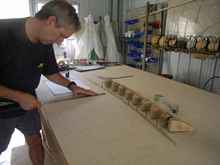| Thinking about building a boat is
a very exciting thing. For most of us it involves a lot of procrastination,
planning, dreaming, mind-changing and so on. The actual building
process can often end up being more simple than the original thinking
about it. I’ve frequently advised people to just get on
with it, and nine-out-of-ten of the problems you’ve dreamed
about disappear. The job provides the answers as you go along.
When I’m preparing my plans packages for publication, I
find that writing the instruction manuals I supply with plans
is the most difficult part. Personally, I’m very happy to
work from plans which have no instructions at all – letting
the job instruct me as it progresses. To have to write down on
paper a single, specific way of doing a particular job is quite
confronting. That is probably why many designers leave detailed
instructions out and just rely on an accurate specification and
building key.
All very well, you may say, but you already know how to build
a boat. Well, yes, but undertaking the construction of a boat
is a serious business (it should also be fun), and everybody should
carry out adequate research before starting out on what is a complex
and unfamiliar project.
For most people, this interest in boats is a hobby to be pursued
after the other responsibilities in life have been attended to.
Not many of us have the opportunity to build large numbers of
boats, and without expert tuition, it is difficult to pick up
skills prior to commencing construction of the one or two boats
which a normal lifetime allows.
I receive hundreds of emails about boatbuilding, designs, rigs,
rowing and sailing. The vast majority come from people who are
highly enthusiastic, but lacking in confidence and specific experience.
A recent contact illustrates the sort of thing I’m talking
about, and allows me to explain some of the potential pitfalls
– as well as the opportunities.
An email turned up from a fellow who is currently building a
simple sailing dinghy from a well-known Australian designer. The
boat is an excellent example of sensible design, and represents
a very good project for an inexperienced builder. I’ve built
a few examples of this particular design for customers, and they
have proved to be seaworthy, relatively comfortable, rugged, and
they sail beautifully. Additionally, the plans are well detailed,
and the specifications for materials result in a boat which is
plenty strong enough for rugged use.
|
Mike Robert's-designed Green Island 15 - a good
boat |
The fellow who contacted me is a very capable and intelligent
person, and his approach to the job was, and continues to be,
very thorough. However, he had become hung-up on whether certain
aspects of his workmanship were up to standard, and called me
in to tell him what was wrong.
There was nothing wrong! Every part of this boat had been built
exactly as designed, although the builder was concerned about
the standard of his work, and he did not have the benefit of prior
experience to gauge the required standard. It is ok if you start
work as an apprentice in a boatbuilding establishment –
each and every day an apprentice is exposed to the standards which
are considered acceptable – but when you work alone at night
and weekends you are largely in a vacuum, relying on books to
provide the guidance.
In the case referred to above, there were a few minor inconsistencies
in the plans which would not even have been noticed by a professional,
but to the novice builder who called me in, they caused serious
head-scratching.
Generally speaking, it is not enough to rely totally on the
instructions supplied by the designer. The designers all have
their own favourite methods of construction, but that doesn’t
mean that their method is the only suitable one, nor even that
it is the correct one. You must carry out your own research –
reading, talking, observing, making test pieces yourself –
the list goes on.
Now, the danger is that a line has to be drawn between what
you can change and what you can’t! The good designers (and
trust me when I tell you that there are plenty of bad ones) will
have put a lot of thought into each and every element of their
work, and you should not alter the design without having either
the designer’s permission, or a very clear understanding
of what is involved. That means having lots of experience and
a substantial understanding of the engineering involved.
 |
Concentrating on an accurate mark-out –
plans at hand |
But, it is possible to alter the way in which a boat is physically
assembled without altering the shape, weight, strength, and
looks of the resulting structure. In the notes and instructions
which accompany my own design packages, I try to explain why I
do things a particular way, and if there are acceptable alternatives
I try to make mention of the fact in the text.
While it may be ok to alter the method of construction
(as long as the alternative is suitable from an engineering point-of-view),
it is definitely not acceptable to alter the shape, weight and/or
proportion of a design without consulting the designer or a Naval
Architect with experience in small craft design. This even includes
such apparently simple matters as altering the mast material,
or putting in a self-draining cockpit.
 |
Flint
- simple to build, but properly engineered |
Lastly, before you commit to the purchase of plans, ask the designer
which engineering standards or scantling rules the boat has been
designed to comply with. The boat you build may be required to
carry many other people in its service life, and you had better
be sure that its design and construction meets an acceptable standard.
See, there I am writing yet another lecture! Sorry, readers….
On a lighter note, I’m in the process of gradually up-dating
my website www.baysidewoodenboats.com.au
, and hope to have more pages containing edited discussion about
a host of different design, building, rigging and general boating
matters. Over the last ten years I’ve answered literally
thousands of emails from people, and within the archives there
are some valuable question/answer interchanges. It has always
seemed a pity to me that other people could not benefit from the
discussions.
Keep up your enthusiasm, build simply - but build to the very
best of your ability, and have fun!
***********

|

